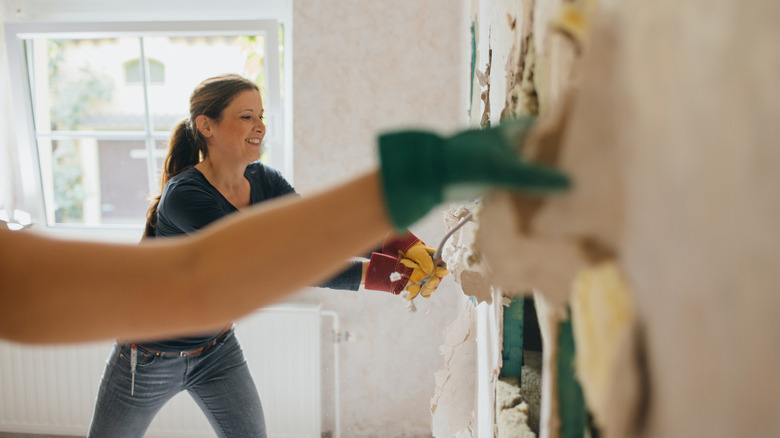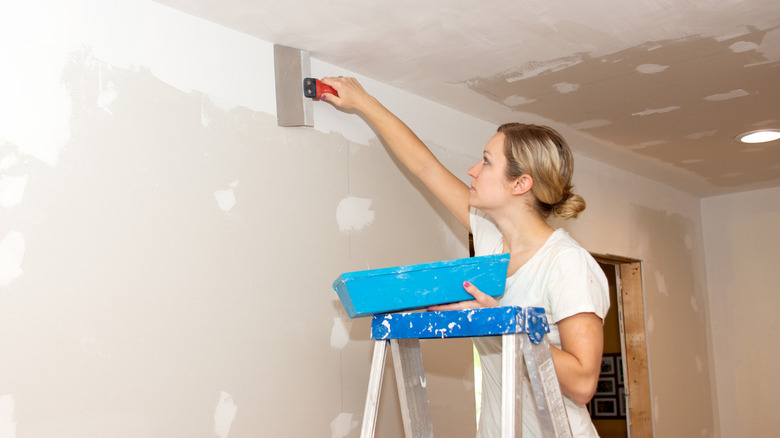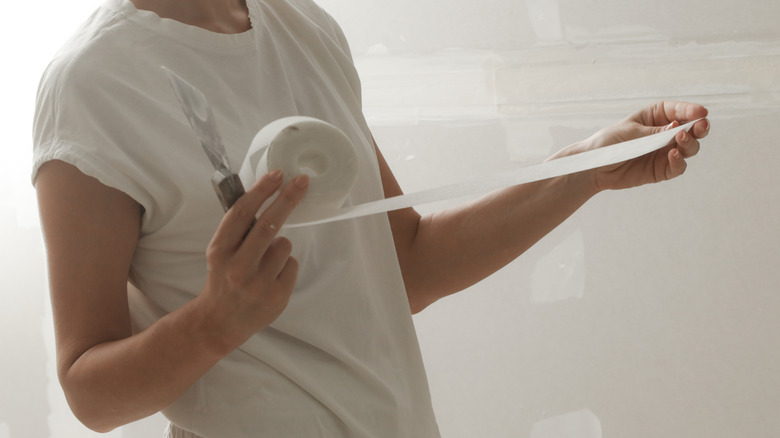The Drywall Mistakes That Could Ruin Your Home Renovation
We may receive a commission on purchases made from links.
Renovating a home can quickly become a major headache. From running into budget issues to making mistakes that impact the quality of the finishes, DIY isn't for the fainthearted. Whether you're simply changing the location of a single wall, finishing an attic or basement, or adding an entire floor, most renovations come with at least some drywall installation. But according to Lydia Crowder, aka @DrywallShorty on Instagram, trying to save on materials by piecing together boards, using the wrong screws, and forgetting to slightly water down your joint compound are drywall mistakes that could ruin your home renovation.
"When it comes to installing and finishing drywall, you really need to plan what you are doing and make sure you have adequate amounts of material for the job," Crowder told House Digest during an exclusive interview. It's common for first-time drywall installers to use pieces from several different boards to avoid material waste. It's also a big mistake. "All that creates is more joints to finish, more work, and increases the chances of seams showing later," the drywall expert explained.
You may also run into issues with your drywall screws and finishing work. "Drywall board needs quite a bit of screws to hold it, and if you are not setting them correctly, it can cause a lot of problems later," Crowder said. "Finishing drywall and floating joints correctly can be very tricky, especially if you have no experience with the tools," she added. "Anything you put on the wall you're going to have to sand and make smooth, so keep that in mind when you are applying your joint compound," she suggested.
Using cheap tools and the wrong sanding techniques
"Drywall finishing is a very labor-intensive project and takes a lot of time," Lydia Crowder said during her exclusive interview with House Digest. "Do not expect to have it done quickly or easily." She emphasized that the process can be a frustrating one to learn, let alone master, so you should keep your expectations in check if it's your first time. "Start in a small room to get a feel for how the process works, the time needed, and allow yourself to get used to the tools and equipment," Crowder suggested.
The drywall expert said the best results come from using the right tools — so avoid those of the flimsy plastic variety. Along with high-quality pans, knives, and trowels, such as the ones you can find in the LEVEL5 Drywall Finishing Hand Tool Kit from Amazon, Crowder recommended investing in a good mixing drill. A drywall T-square is another handy tool that will make your next drywall project a breeze. "If you are using low-quality items, your finish will not be as good or easy to accomplish," she cautioned.
According to Crowder, you should also give careful thought to your drywall compound and sanding if you want to get a professional-looking finish. It's easy to mistakenly use the wrong ones if you don't do careful product research before getting started. "There are a lot of available compounds ... and if you assume they are all the same or use the wrong compound, it can create major issues down the road," she explained. The drywall expert also warned against sanding papers that are too aggressive, recommending that you use only 150-grit paper or higher.
Minimize drywall joints to achieve the best possible results
According to Lydia Crowder, you'll get the best possible finish if you "hang full drywall sheets whenever possible and avoid using small pieces." During her exclusive interview with House Digest, she emphasized the need to keep your drywall joints to a minimum. "Any joint you make has to be finished, so remember that when you are hanging [each board]," she said. The drywall expert reminded DIYers to use specialty drywall screws because they are made specifically for drywall finishing. She recommended using a drywall hanging gun to make sure the screws get set correctly. "The best way to avoid a screw pop is to make sure you have your screws set at the proper depth and not drive the screws too far through the drywall board," Crowder added.
Although she shares everything you need to know to hang drywall like a pro on her popular Instagram account, Crowder offered us a few other tips you should keep in mind. She strongly recommends thinning your joint compound with a small amount of water rather than using it directly out of the bucket or box. "It's important to apply thin coats that feather into the drywall board to minimize joints flashing and keep sanding to a minimum," she said. Of the tools she uses, she added, "Typically, I have a 6", 8", 10" and 12" knife on the job at all times and I use all the sizes at different parts of the project." After calling mesh tape "a nightmare," the drywall expert said she prefers using USG All Purpose Joint Compound with paper tape.


